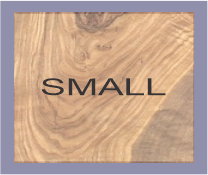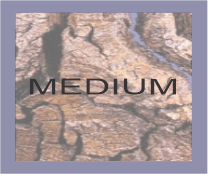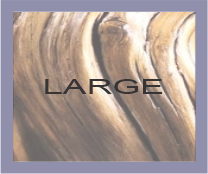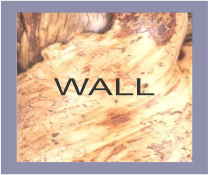|
The Amazing Forest
Trees clean our air and create oxygen. They provide medicine and food and give us shelter, timber, and fuel. They are beautiful, majestic, and a source of great inspiration. Many sculptors use wood in their work; most use dimensional lumber far removed from the original tree, some start with a piece of a tree and carve it into recognizable forms, some coax the living tree to grow into fantastic shapes. Forest Sculptures use tree trunks, branches, bark, and roots in their innate form; they are a product of the natural world.
A trip through my showroom (or online store) shows the incredible range of personalities. The forms are sinuous or solid, branching or enclosed with a variety of marbleized grains. The colors range from light gray to tan to deep brown to red. Some pieces were scorched in wildfires and are a beautiful iridescent black. The texture can be smooth, punctuated with insect holes, or rough and scaly, all begging to be touched and exuding the innate warmth of wood.

Let's Go Shopping!
When I go to the forest to find wood, I call it a shopping trip. I find the wood for my Forest Sculptures in many places: on mountain slopes, in woods and by rivers, in towns and in wild areas, on roadways and in my own backyard. I often see pieces of wood just by chance while engaged in some outdoor activity such as hiking, horseback riding or just driving, while other times I go to the forest for the express purpose of “shopping”.
Sometimes when I’m hiking, I literally trip over a beautiful piece of wood; I call these “gifts.” Usually, though, I see a piece from a distance as I walk or drive by. At first, something dramatic catches my eye: an intense color, a curious texture, or an elegantly twisted branch. This causes me to stop and evaluate the piece to see if it will survive the “2-second kiss of death”, that it has enough artistic impact so that I will be drawn in and intrigued by it for more than two seconds.
This initial assessment is made from a distance; it determines whether or not I walk over to and, if necessary, extricate the piece for a more thorough evaluation. I look at all sides and judge its artistic merit as well as considering practical aspects such as its size and structural soundness. Whether intentionally or subconsciously, I’m always on the lookout for interesting pieces. It only takes a few minutes to go through the entire assessment described here, and determine whether I’ve found my next Forest Sculpture.

The Transformation
 When I bring a new bit of wood home, the first thing I do is clean it so that the dirty, raw, encrusted, piece is brought to a state where the ultimate sculpture is readily apparent. I remove dirt, mold, lichens, insects, and excessively rotted wood, keeping in mind that these sources of decay are what causes the amazing textures and too much cleaning may be detrimental to the artistic appeal. I prefer to do this step outdoors; it gives the mold and insects a place to go other than my studio. I often pause during this process, leaving the wood outside overnight to give any disturbed insects an opportunity to vacate before I resume my work. If I bring a piece inside too soon, it can make the sculpting process interesting. I found one piece in winter and decided to work on it right away. The warmth of the studio combined with my disturbances woke some hibernating ants. Interestingly, they did not wake all at once, rather, every half hour or so one would come crawling out; this went on for three days. I usually clean several pieces at one time, then ensure they are dry and store them away for future use. When I bring a new bit of wood home, the first thing I do is clean it so that the dirty, raw, encrusted, piece is brought to a state where the ultimate sculpture is readily apparent. I remove dirt, mold, lichens, insects, and excessively rotted wood, keeping in mind that these sources of decay are what causes the amazing textures and too much cleaning may be detrimental to the artistic appeal. I prefer to do this step outdoors; it gives the mold and insects a place to go other than my studio. I often pause during this process, leaving the wood outside overnight to give any disturbed insects an opportunity to vacate before I resume my work. If I bring a piece inside too soon, it can make the sculpting process interesting. I found one piece in winter and decided to work on it right away. The warmth of the studio combined with my disturbances woke some hibernating ants. Interestingly, they did not wake all at once, rather, every half hour or so one would come crawling out; this went on for three days. I usually clean several pieces at one time, then ensure they are dry and store them away for future use.
I sculpt a piece in phases. After the first phase of “cleaning”, I do what I call “preparation” where I am focused on making the piece strong and stable. I start by cutting off any parts that are obviously not part of the sculpture. I also remove any parts that are too fragile to sustain the jostling rough handling my sculptures get when I pack and haul them to shows. Then I repair cracks with glue and strengthen decayed areas. I finish the preparation with a coat or two of varnish, liberally applied so that it seals every nook and cranny. This is an exhilarating experience as the varnish intensifies the dramatic color and grain, bringing the sculpture to life.
In the next phase of work, I refine the piece of wood into a fine art sculpture. I do what I need to do to heighten the sculptural qualities of the piece and rely on my earlier work to have addressed its physical properties. Rather than work in an orderly manner from top to bottom or side to side, I work impulsively, running my hands all over the piece to identify an offensive area and then adjusting it. I develop a sort of emotional connection with the sculpture and keep working it until it “tells” me that it is done.
Once the sculpting is complete, I finish the surface of the wood. This often involves another 3-4 coats of varnish, applied over the course of several days, with occasional sanding and adjustments in between. The transformation is amazing – somehow this finishing brings all of the characteristics of the piece together, creating a unique work of sculptural art resplendent with color, form and texture.
Finally, it is time to mount the sculpture on a base. There are both artistic considerations such as the size of the base and the particular orientation of the piece, and engineering aspects such as the sculpture’s stability and the strength of the bond to the base. Mounting on a base shows off the best of a sculpture and ensures that is stable and durable for display in your home or office.

What’s in a Name?
A name may seem an unnecessary addition to a Forest Sculpture (or any sculpture for that matter); however, to the viewer it provides an important frame of reference; it helps tell the story of the piece, evoking an emotional response, creating a personal connection. For many sculptures, its name is apparent the moment I see it in the forest. Others name themselves as I work the piece and get quite intimate with its characteristics and personality. When I sign each sculpture, I also label it with its name and serial number, and it is accompanied by a “birth certificate” with information further about its origins.
Care and Feeding
Each Forest Sculpture is well sealed and requires only an occasional dusting. Since a cloth may snag on the intricate textures, I recommend using an inexpensive 1-inch paintbrush.
Selecting Your Forest Sculpture
With such variety, how do you choose the perfect piece for your home or office? My customers typically follow one of two routes. Some people have a particular spot in their house and they look for the sculpture that enhances this spot. The dimensions of the piece are as important as its character. Others are drawn to one particular piece amid a collection of all various sizes and personalities. I’ve had customers evaluate every piece on display but they inevitably come back to the first sculpture that “called to them”. Colorado Forest Sculptures also make unique gifts.
I offer a money-back guarantee when you shop online so you may purchase with confidence. Customer satisfaction and product quality are the key values of my shop.
|









